Finally, we hit the Spanish Military Hospital Museum. Now, let me warn you, it isn’t pleasant, it isn’t pretty - in fact it’s pretty gruesome. Then, in the middle of the description, I’m going to get queasy and have to sit down. I’m not proud of this but it is what it is.
Actually, the Hospital is a reconstruction of 1 of the 3 original buildings of the hospital which stood on this spot during the Spanish period from 1784 - 1821. When the Americans took over in 1821, the hospital stayed open for 2 more years and then closed down. Several buildings were built over the lots but the last building was demolished in the early 1960s. Archaeological digs at that time uncovered the original foundations of the hospital building. Using those foundations and the Spanish records of the hospital, the building was reconstructed. And, that is what we toured. There was an apothecary and a doctor’s residence which are private homes now.
The tour covers the doctor’s office, a room that today would be called a hospice room and several wards where patients were housed. We were surprised to see the comparison of Spanish medicine in the 1700’s to American medicine at the same time. Doctors in Spain were required to have a license and to get this they had to attend college, medical school and serve an internship. Not in America. Just about anyone could declare themselves a doctor and have a go at it until the first medical degree was available in Philly and NY in 1765. The Spanish realized that there was a relationship between fresh air, sanitation and good diet to good health. Hey, lets wash our hands a lot to prevent germs from spreading. Hey, let’s separate patients so they don’t catch each other’s diseases. You, know little sanitary practices like that which were pretty uncommon at that time. American doctors thought that all patients could be housed together which would be more economical, windows should be closed to prevent bad air from getting in and that diet didn’t have much to do with good health. Actually the Spanish had learned a lot from the Moors who had inhabited and ruled their country earlier.
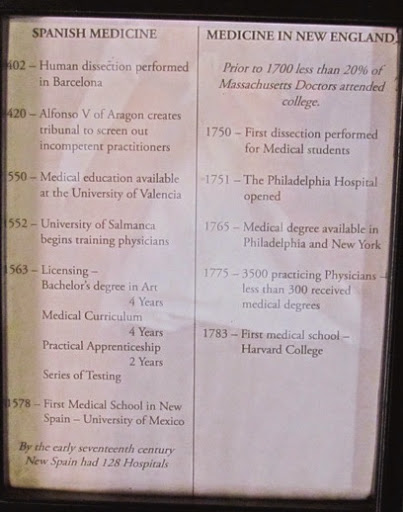
The death rate in Spanish hospitals was much lower than that in British and American hospitals and that is why the hospital closed after the Americans had run it for a while.
Our Spanish Military Hospital Museum guided tour started with a trip to the hospice area. There was a small bell on the dresser to the left because: several hundred years ago when someone was dying, the hospital would ring a bell to summon family on the alert at home. And that’s where we get the saying: ‘For whom the bell tolls.’
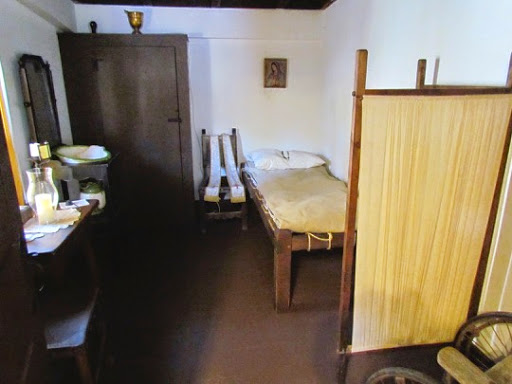
OK, here’s the surgical table and here’s where it gets dicey.
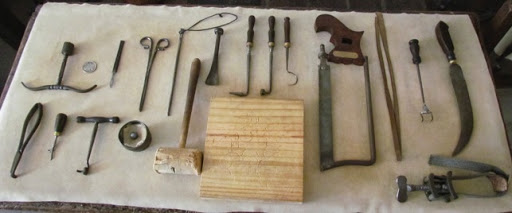
In the upper left is the tool used to make a round hole in a patient’s head to remove the skull so the brain can swell when traumatized. The coin there is to put on the hole when the brain has healed. Seems the patient had to bring his own coin. That long skinny pencil-shaped metal bar with the round leather strap at the top was to insert into a bullet wound to fish around to try to find the bullet. It was magnetized on the end so it could pull the bullet out. Didn’t want to lose that metal bar if you had to go in deep so you used the round rope to pull it out. Tooth removal tools in the lower left hand corner. Guess what the saw was for? The lower right thing is a tourniquet that could be screwed tighter and tighter to close off the blood flow. How to remove a finger if it was infected or injured? It involved that board where the patient laid his finger, that mallet and the triangular metal piece above the board. ‘WHACK!’ out guide said loudly. Go on, imagine that operation and see if you don’t get lightheaded also. At least it was fast.
Our guide proceeded to show us how each and every one of these instruments was used: from the huge saw used to amputate bones to the small instruments to pull teeth. That’s the sanitized version. She actually went into great detain on the steps the surgeon went through to find the bone to saw and what was done with the flesh and the skin. I’m not sure but I think it was during the discussion of the arm amputation that I realized that I was a bit lightheaded and I should sit down. I made it look as if I was tired of standing and both the guide and Gary fell for this. HA! Only I know the truth - well, now everyone of you who is reading this will know too.
Funny, our guide told us that doctors and dentists that take the tour say they use some of the same instruments today not quite the same and certainly in better condition.
I’m thinkin’ that our guide usually does school kid tours and don’t they live on blood and guts? But the rest of the tour was about herbs and other sanitation practices of the Spanish. We even saw the herb garden. Most of the ‘medicines’ they used here came form Spain and, when the supply ship was captured by pirates or didn’t arrive at all, the apothecary had to made due with those herbs and medicines he had on hand.
We enjoyed the tour and our guide was superb. She gave us blood and guts but also history and medical practices of the times. Just remember this if you have a ‘delicate’ stomach.
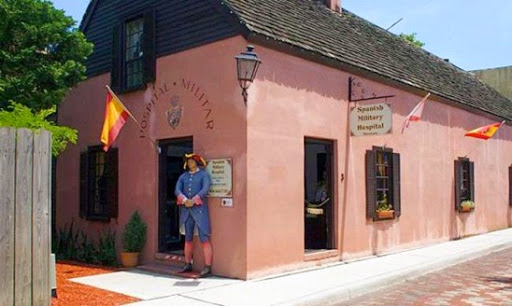
We walked back to the car through the city. By the way, it’s bike week here. Pity the poor tourist who doesn’t know that bikes get priority parking around the City Square during Bike Week.
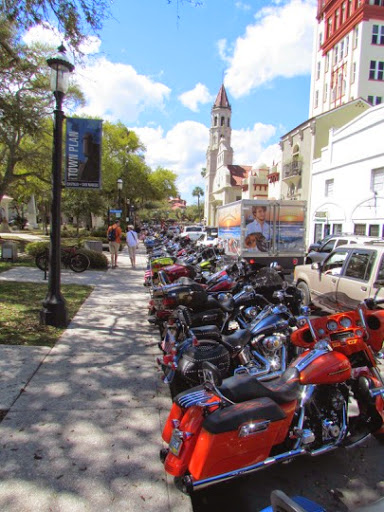
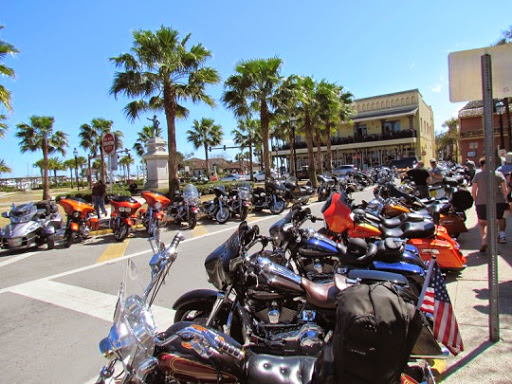
Home late and while Gary unhooked some of our utilities, I took the trash to the nearest trash barrel, which in on the other side of the south end of our campground. Oops, some one has put an 8” thick, 6’ long mattress into the trash and nothing else will fit. Did they bring it from home to trash here? Amazing. So I walked over to the far end of the other side of the campground for the less full trash container. Hey, it was a good walk - but carrying two wastepaper baskets?

No comments:
Post a Comment